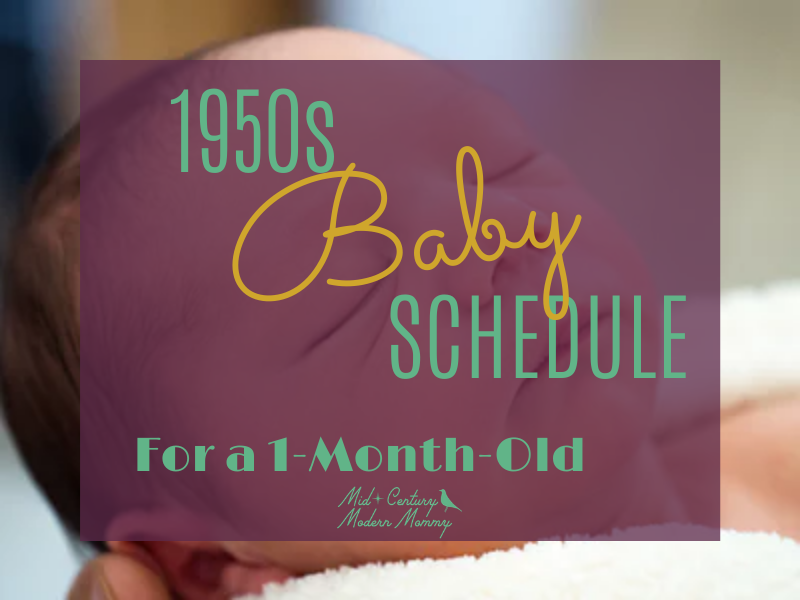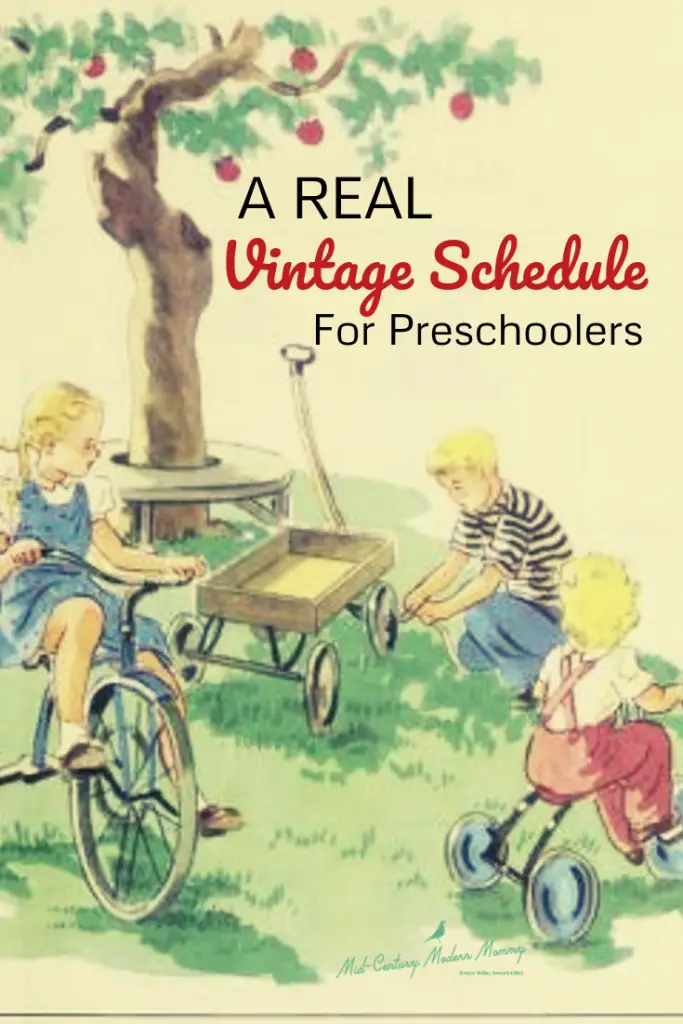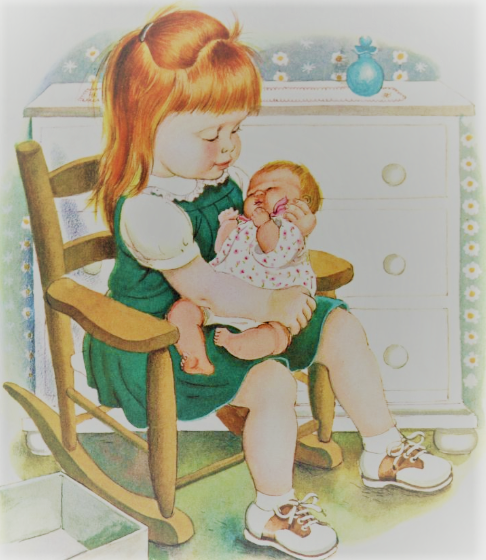It’s no secret how much I love vintage parenting ideas. And one of my favorites is the idea of nursery meals. It just has SO MUCH going for it. You have babies and little ones who you can make sure have eaten healthy meals, so that family meals can actually let YOU have time with your husband. Because you don’t have to spend the whole time feeding the babies and they aren’t angry, so they aren’t fussy! Win-win! In this post, I will talk about what nursery meals are and how to make them work in your life.
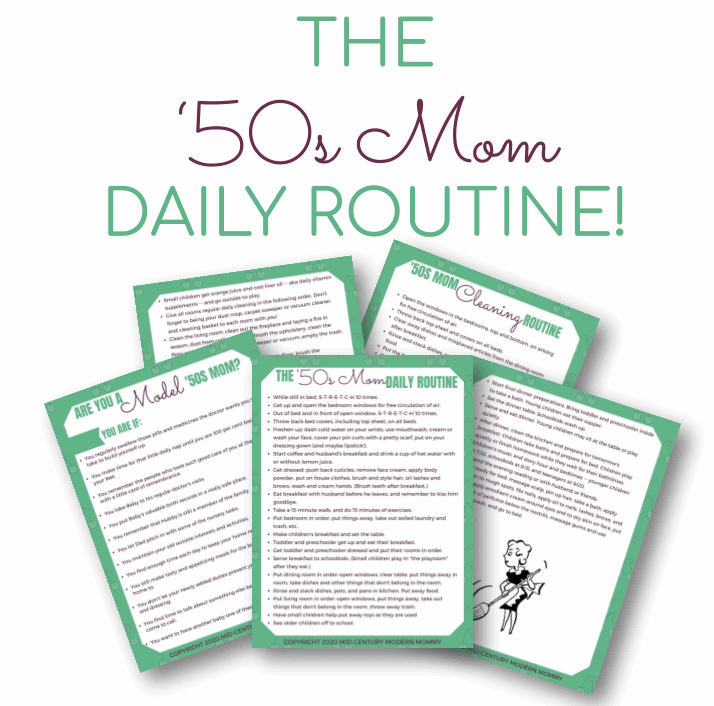
Get Our Mid-Century Mom Daily Routine FREE!
- The Best Way to Feed Preschoolers
- Vintage Nutrition for Preschoolers
- How to Feed an Infant After Starting Solids
- How to Feed a Toddler
- How to Feed a Preschooler
- How to Cook for a 2 to 6 Year Old
- How to Plan Nursery Meals With The Family
- Adapting Nursery Meals For Parties
- How to Fit Nursery Supper Into the Evening Routine
- Resources

The Best Way to Feed Preschoolers
This post contains affiliate links. If you click a link and make a purchase, I may receive, at no additional cost to you, a small commission. Find out more on my Disclosures page, and thank you so much for your support!
The 1940s was a time when homestyle cooking and wholesome ingredients were the norm, and I have seen that these types of meals benefit the health and wellbeing of young children today — my own! While there are certainly some challenges to adapting these meals to modern dietary needs, the retro coziness and the potential health benefits make serving nursery meals to preschool children one of the best vintage parenting ideas around.
In the 1940s, nursery meals were often simple and straightforward. Breakfast was usually cereal, toast, and milk (occasionally eggs), with a dose of orange juice and cod liver oil, instead of processed vitamins.
Lunch and dinner often included meat, cheese, or egg, vegetables with butter or white sauce, potatoes, pasta, or rice, bread and butter, and dessert. Sometimes, the meat and vegetables were combined into a soup with real broth. Desserts were fruit- or milk-based simple things like pudding or cooked fruit.
Processed foods and convenience meals were not as prevalent as they are today. Overall, meals were focused on providing nutritious and filling options for growing children.
Vintage Nutrition for Preschoolers
In the 1950s, a child’s nutritional requirements were primarily focused on providing enough energy to support growth and development. The main food groups emphasized were milk, meat, eggs, fruits, and vegetables. There was also a strong emphasis on consuming foods that were high in vitamins and minerals, such as citrus fruits for vitamin C and leafy greens for iron. And of course, bread-and-butter were the foundation of every preschooler’s meal.
How to Feed an Infant After Starting Solids
Feeding a baby less than 12 months was all about establishing the right habits and focusing on what kind of vitamins and nutrients were most needed for optimal growth. The diet of the infant relied heavily on most of the necessary nutrients being delivered via 1 quart of whole milk daily, supplemented by cod liver oil, orange juice, and a few tablespoons of banana. Everything else was a bonus, and it recommended that spinach be prioritized.
Before he was a year old, your baby would have at least a nodding acquaintance with nearly every group of food. He was eating three meals a day, with the big meal at noon.
Daily menus usually looked like this:

This was also the time to start establishing habits around feeding. The most important habit was to feed them by themselves, away from the rest of the family. There were many reasons for this.
First and foremost, you (the mother) could devote your attention to making sure that the baby was fed. Making the baby the center of attention was not recommended, because the baby was not supposed to be the center of the family. The purpose of the family meals was for the husband and wife to reconnect, and to touch base with their older children through conversation. Feeding the baby first, and then merely including him at the table, was seen as keeping the focus where it should be.
Also, it was a way to avoid the baby picking up bad eating habits. He could be encouraged to try all the new things. Usually, this followed a pattern of just giving a taste. If the food wasn’t liked, another taste would follow a few days later, until he would accept it readily.
Here are some of my posts about vintage schedules. Many of them include the recommended diet for that age group:
A REAL 1950s Baby Schedule for a 1 Month Old
The best thing about raising children in the “good old days” was that there was…
Vintage Schedules For Preschoolers (What a REAL 1940s Expert Recommended)
The 1950’s Baby: 8 months old schedule
It has been brought to my attention that I have not been posting my baby…
The 1950s Baby: Care & Schedule for Baby Two Months Old
Baby #8 is two months old already (heavens above, how time flies)! As we move…
Schedule Your Toddler’s Day
Just the word schedule might make you cringe. After all, sometimes it feels like you…
How to Feed a Toddler
The toddler year in vintage child-rearing is a time of shifting. During this year, you potty-train your child and also transition them from infant to child in activities and behavior.
A one-year-old may share the fruits you cook for the rest of the family. Just chop up his portion. Raw fruits, except berries and melons, may be given if they are thoroughly ripe. Peel apples, pears, plums and peaches and slice for out-of-hand eating. Here are some menus, one-year-old style:


Feeding the baby becomes easier now that he can eat the same foods as the rest of the family. At breakfast, he may have some of the family cereal, fruit, toast, and even some of the eggs, if you scramble or hard-cook them.
At noon, since he still eats his big meal in the middle of the day, you may want to rely on canned baby foods, or you may give him some of the meat and vegetables left from last night’s dinner. (Each evening put aside a little meat, a little vegetable, and perhaps a bit of pudding for the baby’s dinner the next day.)
For supper, he may have an egg, if he did not have one for breakfast, or soup (perhaps some left from the older children’s lunch), or scalloped potato or macaroni and cheese (prepared for the family dinner), fruit, milk and a cracker or two.
Continue to have him eat his meals by himself. He can now have his own little table and chair, and probably wants to feed himself. Provide a place in the kitchen that is easily cleaned if he’s messy. Very likely he’ll spill — encourage honest effort, but don’t allow him to play with the food or make a mess just for the sake of mess.
After your youngster begins to feed himself, the kitchen is an excellent place, for he can eat while you’re busy getting the family meal and still be undisturbed. You’re at hand to help if help is needed, but you aren’t giving him your undivided attention.
How to Handle Picky Eating
If you aren’t sure whether it is a texture or flavor issue, then start with small bite-sized pieces of food, except for meat, which should be chopped or ground.
Feed 1 piece or a small spoonful — just a taste, the first time. Then allow him to eat as much as he likes of the rest of a meal which includes several of his favorites.
Wait a few days, and then do it again. I sometimes have to do this 5-7 times, but eventually, it is familiar enough that the child is ACTUALLY trying the food, and not rejecting it because of novelty. (It also helps that in our house we have a rule that you aren’t allowed to say you don’t like something unless you’ve actually tried it.)
Since food habits are still being formed at this age, it’s helpful to present the new or disliked food at the first of the meal when the child is most hungry. (If he has already learned to take anything that comes his way, it won’t be necessary to do this.)
Put a fair serving on his plate — about 2 tablespoons of each of the foods for the meal. Give him a small glass or cup of milk — about 4 ounces — and let him eat and drink as he likes. As long as he takes some of each item, it’s not necessary to worry about the amounts. He may have seconds if he cleans his plate. This time, give him about 1 tablespoonful of each of the various foods, and refill his glass with milk. Give dessert in proportion to the amount of other food he has eaten. Let him have as many refills as he wants, but in small amounts.

How to Feed a Preschooler
Your youngster’s diet is altered very little from what it has been throughout the last six months, and will change very little for four years more.
He should still be guarded from rich, greasy, spicy things, from pastries, and from any but the simplest sweets and desserts. Of course, if your child is reasonably healthy, then you can make exceptions — no need to spoil birthdays!
Your child at this age needs an egg every day, two vegetables other than potato, and two fruits, but always check with his pediatrician. Include three-fourths to one quart of whole milk in his diet every day. It’s not necessary to drink all this as a beverage; part may be used in cooking.
Serve fish once a week; liver about twice a week. Two teaspoons of cod-liver oil or the amount of concentrate prescribed by your doctor should be given daily during the winter, and 1 teaspoon, or concentrate as prescribed, in summer. If the milk is fortified with 400 International Units of vitamin D and he drinks a full quart of it daily, this may be sufficient vitamin D for him without any additional supplement. Be sure to ask your doctor about this, also.
As a general rule, serve no food between meals. If your youngster’s hungry, however, a snack is permissible if you’re sure it won’t interfere with the next meal. A cup of milk, an apple, or a graham cracker make the best “snack.” A whole-wheat bread-and-butter sandwich is good also.
How to Cook for a 2 to 6 Year Old
In preparing foods for your child from 2 to 6 years old, continue to make them as easy to handle as possible, and as appetizing as you can. A 2-year-old with sufficient teeth may eat raw vegetables and like them this way.
Wash carrots, lettuce, celery, turnips, cabbage, rutabaga, and cauliflower, remove any tough spots or woody leaves or fibers, and cut into attractive sticks or break into leaves and also. flowers. Soak them in cold water until very crisp, then serve as one vegetable at the meal.
Preschoolers gobble up tiny sandwiches of whole-wheat bread, buttered (cut a regular-size piece of bread into quarters), and filled with bits of raw vegetable or fruit. Any you have on hand may be used this way-apple, carrot, tomato, lettuce, cabbage, and celery. Prepare the vegetables or fruits as above, and cut into thin slices or easily managed bites. Such sandwiches should be passed only after your child has eaten a fair amount of his meal, for the preschooler will fill up on bread at the expense of other foods if you let him.
Make cream soups thick enough so they won’t slip from the spoon. Cut or chop such foods as tomatoes and spinach to make them easy to manage.
Cereals and starchy desserts, like tapioca, cornstarch, and rice puddings, shouldn’t be made too thick. Children like these dishes best when made with about one-half the amount of cereal or starch called for in adult recipes.
Do not use pepper or excessive seasoning. Use one-half the amount of salt you would for an adult, and also use only half the amount of sugar.
Make meat, liver, and fish loaves very moist with plenty of milk and several eggs. Place the loaves in a pan of water in the oven while baking.
How to Plan Nursery Meals With The Family
Feeding the baby becomes easier after the first 2 years, when he can eat the same foods as the rest of the family.
At breakfast, he may have some of the family cereal, fruit, toast, and even some eggs if you scramble or hard-cook them.
At noon, since he still eats his big meal in the middle of the day, you may want to rely on canned baby foods, or you may give him some of the meat and vegetables left from last night’s dinner. (Each evening put aside a little meat, a little vegetable, perhaps a bit of pudding for the baby’s dinner next day.)
For supper, he may have an egg, if he did not have one for breakfast, or soup (perhaps some left from the older children’s lunch), or scalloped potato or macaroni and cheese (prepared for the family dinner), fruit, milk and a cracker or two.
It’s usually easy to alter the family dessert slightly to make it suitable for the younger members. When making layer cake, follow a recipe for 9-inch cake pans, then pour the batter into 8-inch pans and bake what is left in custard cups or muffin tins to serve to the children unfrosted. Or bake cupcakes and leave some unfrosted for the children. Or bake a sheet cake, cutting off enough for the children’s dessert before frosting the remainder.
When the adults have fruit shortcake with whipped cream, the younger children can have some of the fruit plain. For a cream pie, serve some of the filling to the small fry as pudding. When baking fruit pie, put a serving of fruit for each child (less highly sweetened) into a custard cup and bake along with the pie.
It’s a good idea to avoid oversweetening any food for children. Make stewed fruits and applesauce a little less sweet than you and Dad like them; you can always add more sugar to yours. Many children like cereal without sugar, especially if they have always had it that way. If sugar makes a big difference to your child, it is better to let him use just a little rather than skip cereal altogether. The same goes for jam and jelly. Just a taste of them on bread or toast is enough, never a thick layer.
Children do better without highly seasoned foods such as hot chilies, curries and sauces. A child’s sense of taste is more acute than an adult’s and he doesn’t need as much seasoning to make foods appealing. If he becomes accustomed to spicy foods, there is a possibility that he will find the natural, delicate flavors of fruits, vegetables and milk less interesting. Then, too, highly seasoned foods seem to be responsible for some digestive upsets in children. This is primarily why junk food is pushed on to children at such a young age — to encourage future attraction.
Fruit, fruit juice, bread, crackers and milk are the best foods for snacktime. Given not less than 12 hours before the next meal, they are unlikely to spoil the mealtime appetite. When a child gets very hungry just before lunch or dinner and you know the meal will not be ready for fifteen minutes or more, a glass of tomato or fruit juice will tide him over and help keep peace in the kitchen.
Here are 3 menus illustrating how a balanced diet for children can be adapted into interesting foods for the whole family:



Adapting Nursery Meals For Parties
You do not need to serve elaborate menus at young children’s parties, but simple, colorful foods add to the joyousness of the party.
It is well to serve the party meal at a regular meal time, preferably at noon. If this is not possible a party supper at five-thirty in the evening may be served. Of course, the foods used at the evening meal should be easy to digest and may well be served at the close of the party. Attractive sandwiches, simple fruit, gelatin and plain cake mixtures may be supplemented with fruit and milk drinks.
Here are some vintage party menus suitable for young children:


And here’s one for a picnic:


How to Fit Nursery Supper Into the Evening Routine
By far, the hardest meal to adjust to the nursery meal system is the evening meal. This method is very different than what modern families are used to, and it looks very different than a family dinner with older children. Here is the routine that I follow:
First, I start dinner for the family at around 3, just after the children have had an afternoon snack. This gives me a good 2 hours of rest, sewing, etc. between lunch and starting dinner.
By 4:00, dinner is well underway. At this point, I start tidying the house. (This suggestion is part of the Good Wife’s Guide. Since the pandemic, my husband works from home, but I still try to follow the suggestions.) At 4:30, I call the preschoolers from play, and they take their baths. We have a whole routine for this, teaching orderliness, which I also got from the Better Homes and Gardens Baby Book. While they are in their baths, I put together the nursery supper.
Baths are basic — lots of Ivory soap and Johnson’s Baby shampoo — and after baths, the little ones are dressed in clean pajamas, bathrobe, and slippers for nursery supper.
The hour for our nursery supper is 5:00 pm so that the little ones can eat and go to bed by 7:00. The latest bedtime that they have is 8 on special occasions until they are 6 and in 1st grade. (One of the perks of getting older in our family.) They all eat in the kitchen. I putter around, preparing aperitifs and appetizers, and finishing the dinner. This gives me time to help those who need it, and also to work with my ARFID child.
Usually, the children are finished by 5:30. This gives me a half-an-hour to set the table and spend time socializing with my husband. So at 5:30, I set the children to read alone in their rooms or quietly together. I make the house quiet in the evening for my husband to transition back to family life. He has moderate misophonia, and the quiet time is helpful to him. Plus, time for the parents to be together teaches the kids that OUR marriage is more important to the family than they are. (That sounds harsh, but by putting my marriage as a priority for the foundation of the family, my kids feel more secure and behave better.)
Then at 6:00, everyone sits down to the family dinner. With the little ones when they are babies, I usually put them down to sleep. But by 12 months, they are participating. Each child gets some bread-and-butter and some milk, or a few spoonfuls of dinner. They sit and practice good manners, and listen to Mama, Papa, and the older siblings discuss all sorts of topics (most of the time we end up on philosophy and physics for some reason).
Dinner is mostly over at about 7:00. The little ones brush their teeth and head to bed. I read to them, sing to them, tuck them in, and head to the kitchen. Before I had older ones to help with dishes, I would clear the table, put away the food, scrape the plates and throw away the trash, and then go put them to bed and do the dishes afterward. Now I head back to the kitchen to make sure that the older children (elementary through middle school, 3 at a time) are cleaning the kitchen properly, and to prep tomorrow’s meals.
And that’s it! That’s how I make nursery meals work in a big family with lots of littles.

Get Our Mid-Century Mom Daily Routine FREE!
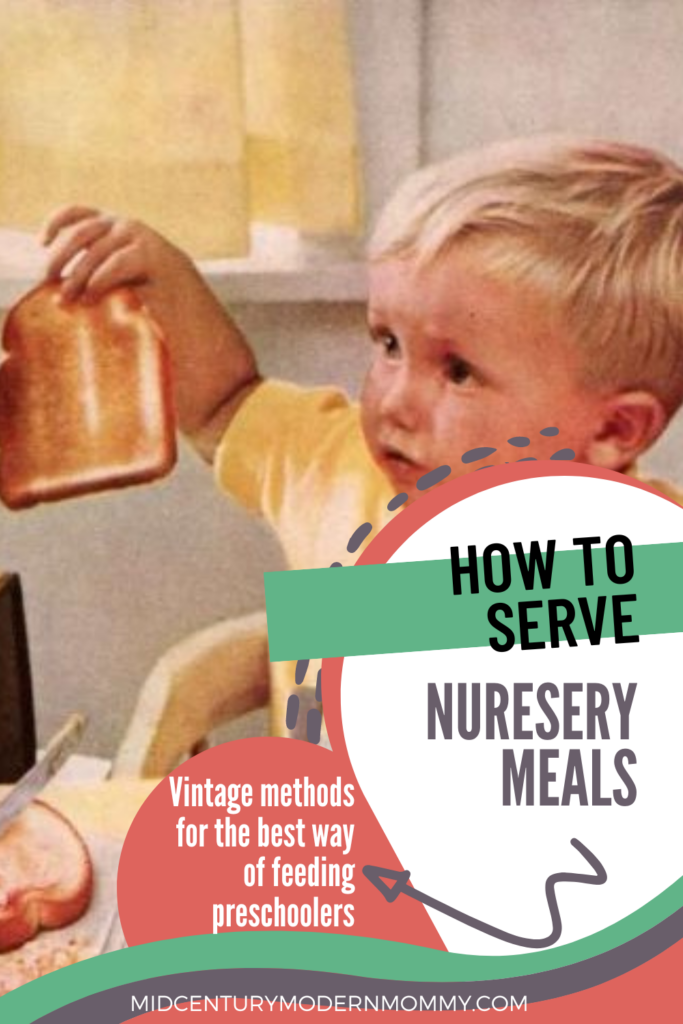
Resources
Square Meals, Jane and Michael Stern
Better Homes and Gardens Baby Book, 1946
Parents’ Magazine Family Cookbook
Food For The Young Child, Miriam Lowenberg

